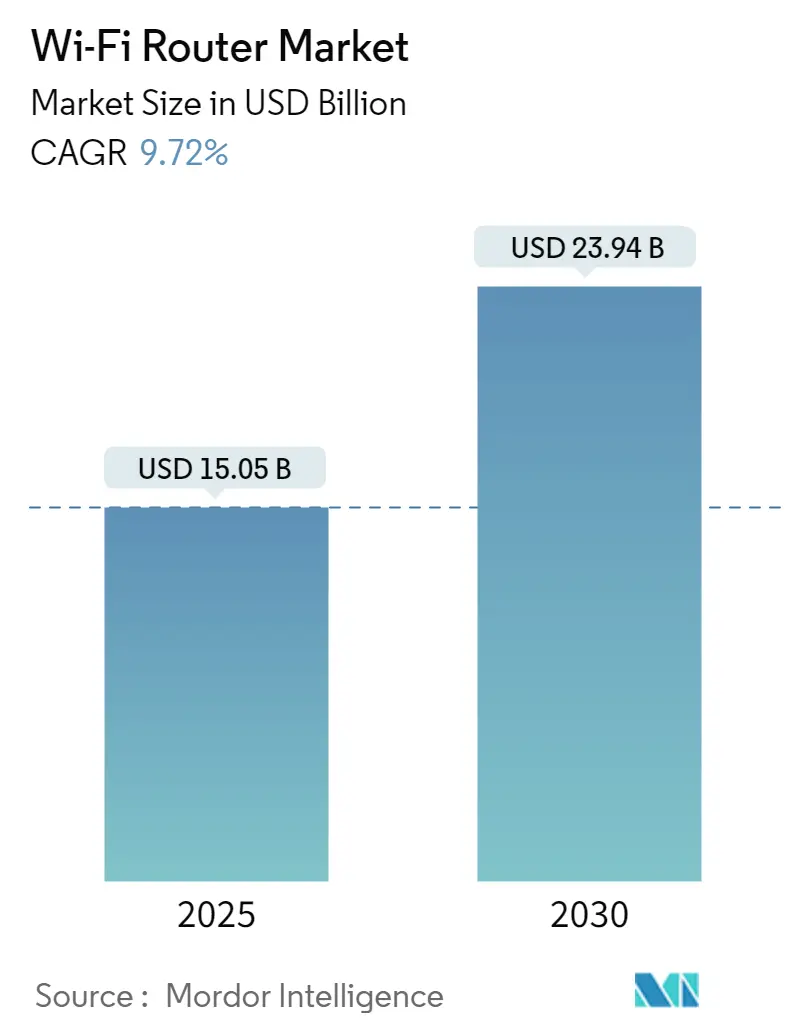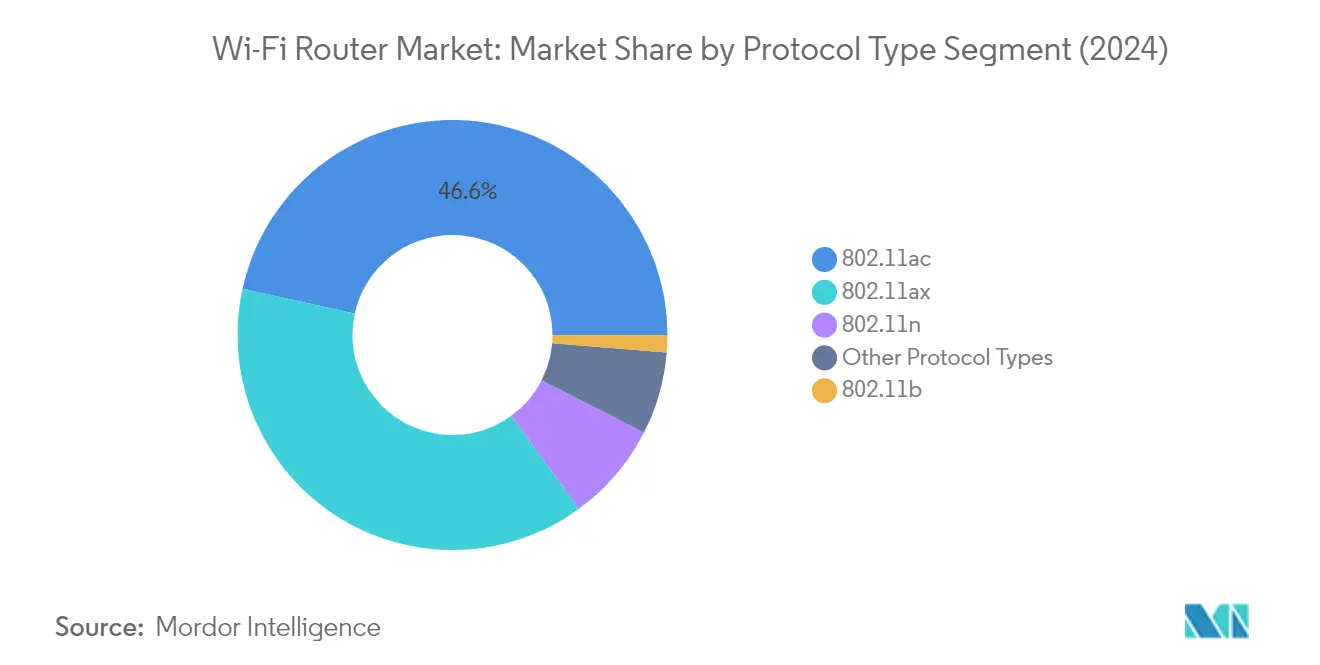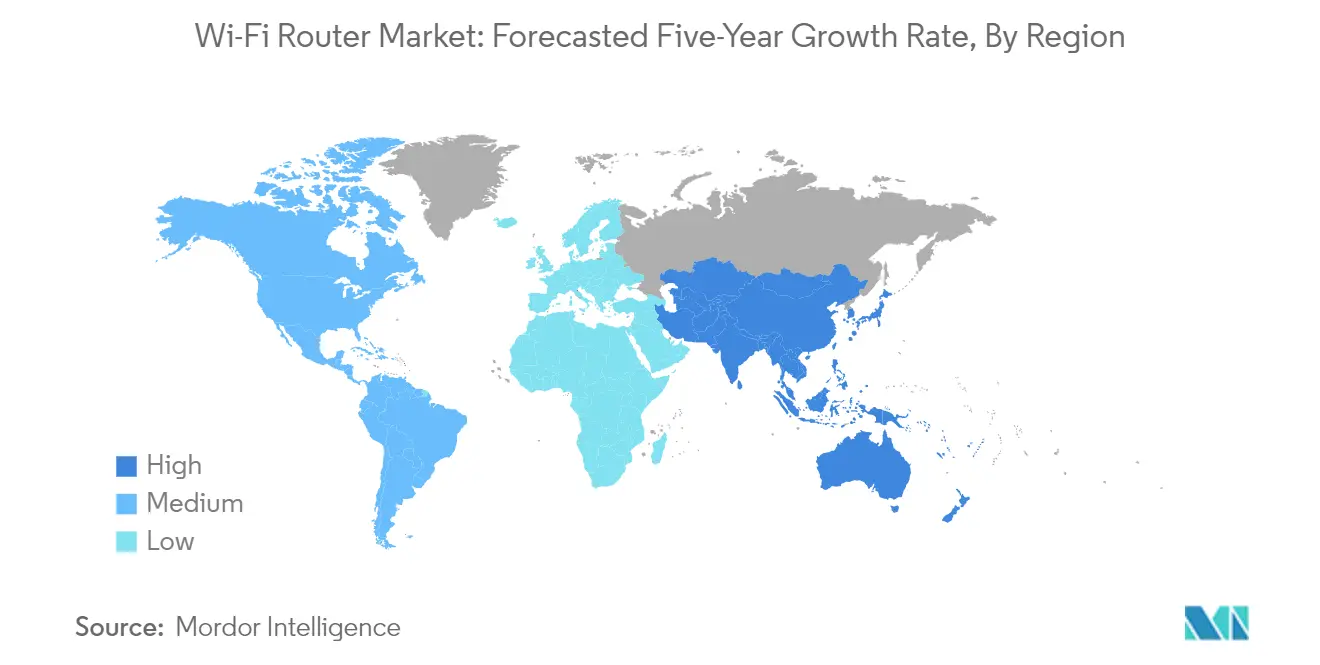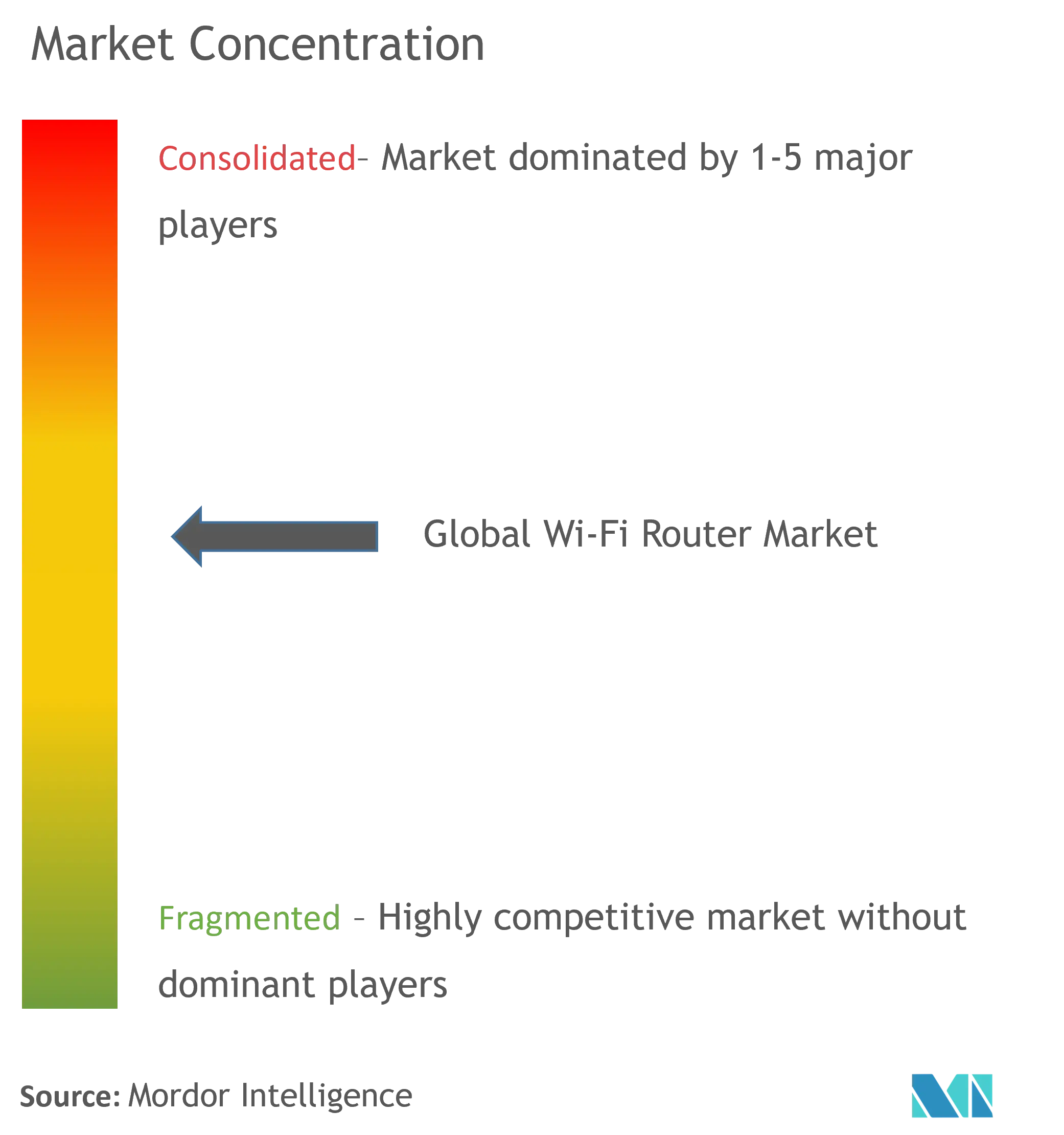
Wi-Fi Router Market Analysis
The Wi-Fi Router Market size is estimated at USD 15.05 billion in 2025, and is expected to reach USD 23.94 billion by 2030, at a CAGR of 9.72% during the forecast period (2025-2030).
The Wi-Fi router industry is experiencing a transformative phase driven by the rapid digitalization of global economies and the evolution of connectivity requirements. The International Telecommunication Union's 2022 estimates highlight this transformation, with approximately 5.3 billion people, representing 66% of the world's population, actively using the internet. This digital revolution has catalyzed the development of advanced wireless communication devices, particularly the emergence of Wi-Fi 6 and Wi-Fi 6E standards, which offer enhanced performance, lower latency, and improved network efficiency. The industry's landscape is continuously evolving with manufacturers focusing on developing routers that support multiple frequency bands and advanced features like MU-MIMO technology, beamforming, and OFDMA to meet the growing demands of modern networks.
The convergence of smart city initiatives and IoT deployment is reshaping the Wi-Fi router market landscape. According to Cisco's projections, the number of networking devices is expected to reach approximately 30 billion by 2023, with IoT devices constituting 50% of all networked devices. This massive proliferation of connected devices has prompted router manufacturers to develop more sophisticated products with enhanced security features, improved bandwidth management capabilities, and support for multiple concurrent connections. The industry is witnessing a significant shift towards enterprise-grade features in consumer routers, including advanced security protocols, virtual private network (VPN) integration, and quality of service (QoS) management.
The enterprise segment is undergoing a substantial transformation with the increasing adoption of wireless networking solutions across various industries. The trend towards hybrid work environments has accelerated the demand for enterprise-grade wireless routers that can support seamless connectivity across distributed workforces. Organizations are increasingly investing in Wi-Fi 6-enabled infrastructure to support bandwidth-intensive applications, video conferencing, cloud services, and real-time data analytics. The integration of artificial intelligence and machine learning capabilities in router management systems is enabling predictive maintenance, automated network optimization, and enhanced security threat detection.
The market is witnessing significant technological advancements with the introduction of mesh networking systems and cloud-managed Wi-Fi solutions. These developments are particularly evident in Canada, where desktop and laptop usage continues to dominate web traffic, with mobile traffic accounting for 38.04% of website traffic as of January 2022. Router manufacturers are focusing on developing products that offer seamless integration with smart home ecosystems, support for multiple IoT protocols, and enhanced coverage through mesh networking capabilities. The industry is also seeing increased attention to energy efficiency and sustainable practices in router design and manufacturing, aligning with global environmental initiatives and regulatory requirements.
Wi-Fi Router Market Trends
Growth in Internet Traffic and Increasing Consumer Demand for Internet-Enabled Devices
The exponential rise in internet traffic and the proliferation of internet-enabled devices are fundamentally transforming connectivity requirements across all sectors. According to Cisco's Annual Internet Report, by 2023, there will be nearly 30 billion network-connected devices and connections globally, with IoT devices making up 50% (14.7 billion) of all networked devices. This massive increase in connected devices is driving the demand for more robust and efficient Wi-Fi router solutions that can handle multiple simultaneous connections while maintaining optimal performance. The surge in e-commerce activities further amplifies this trend, with recent data showing that 2.3% of visits to e-commerce websites in the United States converted to purchases during the second quarter of 2022, while Great Britain witnessed even higher conversion rates of over four percent.
The increasing adoption of smart home technologies and internet-enabled devices is creating unprecedented demands on home networks. This is evidenced by recent consumer behavior trends, where households across developed markets are averaging up to nine wireless internet devices per home, encompassing everything from smartphones and laptops to smart TVs and home automation systems. The trend is particularly pronounced in the gaming and streaming sector, where high-bandwidth applications require superior connectivity solutions. Major manufacturers are responding to these demands with advanced solutions, as exemplified by Google's launch of its Nest smart router with Wi-Fi 6E support in October 2022, offering speeds up to two times faster than traditional Wi-Fi 6 on compatible devices through the new, less-congested 6 GHz radio band.
Exponential Increase in the Bandwidth Requirements Across Enterprises Owing to Digitization
The digital transformation of enterprises is driving unprecedented bandwidth requirements across all business sectors. According to International Telecommunication Union data, global bandwidth use increased significantly from 719 Tbit/s in 2020 to 932 Tbit/s in 2021, representing a 30% gain. This surge in bandwidth consumption is driven by the increasing adoption of bandwidth-intensive applications such as video conferencing, cloud computing, and real-time data analytics. Enterprises require at least 25 Mbps of download bandwidth and 3 Mbps of upload speed to carry out routine duties like emailing, transferring files, and videoconferencing, with these requirements continuing to grow as businesses implement more data-intensive operations.
The enterprise sector's evolution towards more sophisticated digital operations is evidenced by recent technological advancements and implementations. For instance, in October 2022, MediaTek and Aglobal announced a collaboration to roll out 5G and internet routers solutions, specifically designed to support multi-WAN, VPN, SD-WAN, and NMS across various business verticals. This trend is further supported by the development of Wi-Fi 6 and Wi-Fi 6E technologies, which provide enhanced capabilities for handling multiple simultaneous connections in dense environments. The introduction of these advanced protocols enables enterprises to support more connected devices while maintaining optimal performance levels, with Wi-Fi 6E offering significantly improved speeds and reduced latency compared to previous generations. The demand for wireless networking equipment and home networking devices solutions is expected to continue growing as enterprises seek to optimize their digital infrastructure.
Segment Analysis: By Protocol Type
802.11ac Segment in Wi-Fi Router Market
The 802.11ac protocol type, also known as Wi-Fi 5, continues to dominate the global Wi-Fi router market with approximately 47% market share in 2024. This protocol's widespread adoption is driven by its ability to deliver speeds up to 1,300 megabits per second and its compatibility with multiple Wi-Fi broadcast channels for the 5GHz band. The technology's success can be attributed to its advanced features, including extended channel binding, beamforming capabilities, and multi-user multiple-input-multiple-output (MU-MIMO) technology that allows simultaneous data transmission to multiple clients. The protocol's operation in the 5GHz frequency band helps overcome interference issues common in the 2.4GHz spectrum, making it particularly attractive for high-density environments and applications requiring reliable high-speed connectivity.

802.11ax Segment in Wi-Fi Router Market
The 802.11ax protocol type, commonly known as Wi-Fi 6, is experiencing remarkable growth in the WLAN router market, with an expected growth rate of approximately 18% during 2024-2029. This protocol is revolutionizing wireless connectivity with its ability to handle high-density deployments and multiple interfering access points efficiently. The technology's superior features, including 8x8 MU-MIMO capabilities in both downlink and uplink, OFDMA technology, and Target Wakeup Time (TWT) for improved battery life, are driving its rapid adoption. The protocol's ability to serve up to 8 users concurrently and its compatibility with both 2.4GHz and 5GHz bands make it particularly attractive for emerging applications in homes, schools, businesses, and public spaces requiring high-bandwidth connectivity.
Remaining Segments in Wi-Fi Router Protocol Types
The Wi-Fi router market continues to support several other protocol types, including 802.11n, 802.11b, and other legacy protocols. The 802.11n protocol maintains its relevance in applications requiring moderate bandwidth, particularly in cost-sensitive markets and areas where backward compatibility is essential. The 802.11b protocol, while gradually phasing out, still finds limited applications in specific industrial and research settings where basic connectivity is sufficient. Other protocol types, including earlier Wi-Fi standards, continue to serve niche markets but are seeing declining adoption as newer technologies offer superior performance and features for modern networking requirements.
Segment Analysis: By Application Type
Residential Segment in Wi-Fi Router Market
The residential segment continues to dominate the global Wi-Fi router market, commanding approximately 60% market share in 2024, driven by the unprecedented growth in home networking demands. This dominance is attributed to the rising adoption of smart home devices, increased remote work arrangements, and the growing number of internet-connected devices per household. The segment's strong position is further reinforced by the continuous evolution of Wi-Fi technology, with residential users increasingly adopting advanced solutions like Wi-Fi 6 and Wi-Fi 6E routers to support high-bandwidth applications such as 4K streaming, online gaming, and video conferencing. The expansion of residential broadband infrastructure and the increasing penetration of internet services in developing regions have also contributed significantly to this segment's market leadership.
Education Segment in Wi-Fi Router Market
The education segment has emerged as the fastest-growing segment in the Wi-Fi router market, with a projected growth rate of approximately 14% during 2024-2029. This remarkable growth is primarily driven by the increasing digitalization of educational institutions and the widespread adoption of hybrid learning models. Educational institutions are rapidly modernizing their network infrastructure to support various digital learning initiatives, including online course delivery, virtual laboratories, and interactive learning platforms. The segment's growth is further accelerated by government initiatives promoting digital education, the integration of advanced learning management systems, and the increasing use of multimedia content in educational settings. Additionally, the need for seamless connectivity across large campus environments and the rising adoption of IoT devices in educational institutions are contributing to the segment's rapid expansion.
Remaining Segments in Application Type
The commercial, government and public utilities, and other application segments collectively represent significant portions of the Wi-Fi router market, each serving distinct connectivity needs. The commercial segment caters to businesses of all sizes, supporting critical operations and enabling digital transformation initiatives. The government and public utilities segment focuses on providing secure and reliable connectivity for administrative operations and public services. Other applications include specialized use cases in sectors such as media and entertainment, and IT and telecom, where high-performance wireless connectivity is essential for operations. These segments are characterized by their unique requirements for security, reliability, and performance, driving innovation in enterprise-grade mesh router solutions and specialized networking equipment.
Wi-Fi Router Market Geography Segment Analysis
Wi-Fi Router Market in North America
North America represents one of the most technologically advanced markets for Wi-Fi routers, driven by extensive internet infrastructure, high digital adoption rates, and increasing smart home penetration. The United States and Canada form the key markets in this region, with both countries showing strong momentum in adopting next-generation wireless router technologies like Wi-Fi 6 and Wi-Fi 6E. The region's growth is primarily fueled by the increasing demand for high-speed internet connectivity, rising adoption of IoT devices, and the continued expansion of smart home ecosystems.

Wi-Fi Router Market in United States
The United States dominates the North American Wi-Fi router market as the largest country segment. With approximately 82% share of the regional market in 2024, the country maintains its leadership position through advanced technological infrastructure and high consumer adoption rates. The market is characterized by a strong presence of major technology companies, extensive 5G rollout, and increasing smart city initiatives. The requirement for high-speed internet has become essential to match the country's digital transformation journey, with average internet speeds showing significant improvements across different states. The country's market is also driven by the growing trend of remote work, increasing adoption of smart home devices, and the rising demand for high-performance network routers.
Wi-Fi Router Market in Canada
Canada emerges as the fastest-growing market in North America, with a projected growth rate of approximately 10% during 2024-2029. The country's market is experiencing rapid expansion due to increasing government initiatives toward digital infrastructure development and rising internet penetration in remote areas. The Canadian government's commitment to improving connectivity infrastructure through various funding programs and initiatives is creating new opportunities for market growth. The country's focus on expanding broadband access to rural and remote communities, coupled with increasing adoption of smart devices and IoT solutions, is driving the demand for advanced residential routers. The market is also benefiting from the growing trend of smart home automation and increasing corporate adoption of wireless access points.
Wi-Fi Router Market in Europe
The European Wi-Fi router market demonstrates strong growth potential, supported by increasing digital transformation initiatives across various sectors and rising demand for high-speed internet connectivity. The region encompasses key markets including Germany, the United Kingdom, and France, each contributing significantly to the overall market dynamics. The market is characterized by increasing adoption of advanced wireless router technologies, growing smart home penetration, and rising demand for high-performance networking solutions across both residential and commercial sectors.
Wi-Fi Router Market in Germany
Germany stands as the largest Wi-Fi router market in Europe, commanding approximately 35% of the regional market share in 2024. The country's market is driven by a significantly growing client base brought on by the increasing significance of SMEs and rapid adoption of smart devices. The region's demand for reliable and secure internet connectivity continues to grow, supported by advancements in broadband and mobile infrastructure. The market is also experiencing growth due to the rising adoption of BYOD (Bring-Your-Own-Device) trends and expansion of the mobile workforce across various industries.
Wi-Fi Router Market in United Kingdom
The United Kingdom emerges as the fastest-growing market in Europe, with a projected growth rate of approximately 10% during 2024-2029. The country's market is witnessing substantial growth driven by increasing digital transformation initiatives and rising demand for high-speed internet connectivity. The UK's strong focus on technological innovation, coupled with growing adoption of smart home devices and IoT solutions, is creating new opportunities for market expansion. The market is also benefiting from increasing investments in digital infrastructure and rising demand for advanced networking solutions across various sectors.
Wi-Fi Router Market in Asia-Pacific
The Asia-Pacific region represents a dynamic market for Wi-Fi routers, characterized by rapid technological adoption, increasing internet penetration, and growing digital transformation initiatives across various sectors. The region encompasses major markets including China, India, Japan, and South Korea, each contributing uniquely to the market landscape. The market is driven by increasing smartphone penetration, rising adoption of IoT devices, and growing demand for high-speed internet connectivity across both urban and rural areas.
Wi-Fi Router Market in China
China maintains its position as the largest market in the Asia-Pacific region, driven by extensive digital infrastructure development and rapid technological adoption. The country's market is characterized by strong domestic manufacturing capabilities, increasing internet penetration, and growing demand for advanced networking solutions. The market is further supported by government initiatives promoting digital transformation, rising adoption of smart devices, and increasing investments in next-generation wireless technologies.
Wi-Fi Router Market in India
India emerges as the fastest-growing market in the Asia-Pacific region, driven by rapid digital transformation and increasing internet adoption across various sectors. The country's market is experiencing substantial growth supported by government initiatives like Digital India, rising smartphone penetration, and increasing demand for high-speed internet connectivity. The market is further bolstered by growing adoption of smart devices, increasing investments in digital infrastructure, and rising demand for advanced networking solutions across both urban and rural areas.
Wi-Fi Router Market in Rest of the World
The Rest of the World region, encompassing Latin America, the Middle East, and Africa, presents significant growth opportunities in the Wi-Fi router market. The market is driven by increasing internet penetration, rising adoption of digital technologies, and growing investments from various organizations and governments. Many Gulf countries have turned to digital development as a way to attract foreign investment and spur domestic growth, particularly through the implementation of 5G networks. The region is witnessing significant investments in digital infrastructure development and increasing adoption of wireless technologies across various sectors. The market is characterized by growing smartphone penetration, rising awareness of digital technologies, and increasing penetration of wireless internet connections.
Wi-Fi Router Industry Overview
Top Companies in Wi-Fi Router Market
The Wi-Fi router market features prominent players including D-Link Corporation, Belkin International, TP-Link Technologies, NETGEAR, Huawei Technologies, ASUSTeK Computer, and Cisco Systems, among others. These companies are heavily investing in research and development to introduce innovative products with advanced features like Wi-Fi 6 technology, mesh networking capabilities, and enhanced security protocols. The industry witnesses continuous product launches focusing on higher speeds, improved coverage, and smart home integration. Companies are strengthening their distribution networks through strategic partnerships with telecom operators and retailers while expanding their geographical presence through local manufacturing facilities and regional offices. There is also a notable trend toward developing specialized routers for gaming, enterprise router applications, and smart city infrastructure, demonstrating the market's evolution toward segment-specific solutions. Market leaders are increasingly incorporating artificial intelligence and cloud-based management features to differentiate their offerings and maintain a competitive advantage.
Dynamic Market Structure with Regional Leaders
The Wi-Fi router market exhibits a moderately consolidated structure with a mix of global technology conglomerates and specialized networking device manufacturers. Global players like Cisco and Huawei leverage their extensive research capabilities and established brand presence to maintain market leadership, while regional specialists like TP-Link and D-Link have carved out strong positions in specific geographical markets through localized product offerings and pricing strategies. The market demonstrates a healthy balance between multinational corporations and local players, with the latter often holding significant market share in their respective regions through a better understanding of local requirements and regulatory frameworks.
The industry has witnessed strategic acquisitions and partnerships aimed at expanding product portfolios and gaining access to new technologies or markets. Companies are increasingly focusing on vertical integration to better control their supply chains and reduce dependency on third-party manufacturers. The competitive landscape is characterized by a combination of price-based competition in the consumer segment and feature-based differentiation in the enterprise segment. Market participants are also forming strategic alliances with cloud service providers and Internet Service Providers to enhance their value propositions and create additional revenue streams.
Innovation and Adaptability Drive Market Success
Success in the Wi-Fi router market increasingly depends on companies' ability to innovate while maintaining cost competitiveness. Incumbent players are focusing on developing proprietary technologies, strengthening their patent portfolios, and investing in next-generation wireless standards to maintain their market positions. Companies are also emphasizing after-sales support and customer service excellence to build long-term relationships with end-users. The ability to quickly adapt to changing technology standards and consumer preferences while maintaining product quality and reliability has become crucial for sustained market success.
Market contenders are finding opportunities through specialization in specific market segments or geographical regions, offering unique value propositions to differentiate themselves from larger competitors. The increasing focus on cybersecurity and data privacy presents both challenges and opportunities for market players to demonstrate their technological capabilities. Regulatory compliance, particularly regarding wireless transmission standards and data protection, continues to shape product development and market entry strategies. Companies are also investing in sustainable manufacturing practices and energy-efficient products to align with growing environmental concerns and regulatory requirements, which is becoming increasingly important for maintaining market competitiveness. The integration of wireless networking solutions and wireless network infrastructure is also becoming a focal point for companies aiming to enhance their technological offerings.
Wi-Fi Router Market Leaders
-
Cisco Systems Inc
-
Ericsson Inc.
-
Huawei Technologies Co.ltd
-
Juniper Networks Inc.
-
Alcatel Lucent Enterprise SAS
- *Disclaimer: Major Players sorted in no particular order

Wi-Fi Router Market News
- January 2023: Synology has launched RT6600ax and WRX560, extending its product line of critically-acclaimed routers with robust Wi-Fi 6 routers developed to provide fast, safe, and secure internet connectivity to busy households and companies. Running on the intuitive and feature-rich Synology Router Manager (SRM) 1.3 operating system and boasting capable hardware, the routers are fully equipped to manage the challenges of modern web environments, including the vast rise in connected devices and the resulting necessity to protect users against ever-increasing security threats.
- September 2022: ExpressVPN launched its first router with a built-in VPN - the first Wi-Fi 6 consumer router equipped with an onboard VPN. The product called Aircovehas undergone testing from security audit firm Cure53 and is designed to offer users more accessible home comprehensive privacy protection. The router covers a range of up to 1,600 square feet, and its onboard VPN allows for unlimited simultaneous connections.
Wi-Fi Router Market Report - Table of Contents
1. INTRODUCTION
- 1.1 Study Assumptions and Market Definition
- 1.2 Scope of the Study
2. RESEARCH METHODOLOGY
3. EXECUTIVE SUMMARY
4. MARKET INSIGHTS
- 4.1 Market Overview
- 4.2 Industry Ecosystem Analysis
-
4.3 Industry Attractiveness - Porter's Five Forces Analysis
- 4.3.1 Bargaining Power of Buyers
- 4.3.2 Bargaining Power of Suppliers
- 4.3.3 Threat of New Entrants
- 4.3.4 Threat of Substitutes
- 4.3.5 Intensity of Competitive Rivalry
- 4.4 Assessment of the Impact of COVID-19 on the Market
- 4.5 Use Cases
5. MARKET DYNAMICS
-
5.1 Market Drivers
- 5.1.1 Growth in Internet Traffic and Increasing Consumer Demand for Internet-enabled Devices
- 5.1.2 Exponential Increase in the Bandwidth Requirements across Enterprises owing to Digitization
-
5.2 Market Restraints
- 5.2.1 Network Security and Complexities Related to Network Management
- 5.2.2 Usage of Mobile Broadband
6. MARKET SEGMENTATION
-
6.1 By Type
- 6.1.1 Edge Router
- 6.1.2 Core Router
-
6.2 By Organization Size
- 6.2.1 SMEs
- 6.2.2 Large Enterprises
-
6.3 By End-User Industry
- 6.3.1 Healthcare
- 6.3.2 Transportation & Logistics
- 6.3.3 Retail & eCommerce
- 6.3.4 Manufacturing
- 6.3.5 Government
- 6.3.6 BFSI
- 6.3.7 Others
-
6.4 By Geography***
- 6.4.1 North America
- 6.4.2 Europe
- 6.4.3 Asia
- 6.4.4 Australia and New Zealand
- 6.4.5 Middle East and Africa
- 6.4.6 Latin America
7. COMPETITIVE LANDSCAPE
-
7.1 Company Profiles
- 7.1.1 Cisco Systems Inc
- 7.1.2 Ericsson Inc.
- 7.1.3 Huawei Technologies Co.ltd
- 7.1.4 Juniper Networks Inc.
- 7.1.5 Alcatel Lucent Enterprise SAS
- 7.1.6 ARUBA S.P.A
- 7.1.7 Fortinet Inc.
- 7.1.8 Panasonic Corporation
- 7.1.9 Broadcom Inc
- 7.1.10 Extreme Networks Inc.
- *List Not Exhaustive
8. INVESTMENT ANALYSIS
9. FUTURE TRENDS
Wi-Fi Router Industry Segmentation
A Wi-Fi router is a device that performs the functions of a router and includes the functions of a wireless access point with the help of a single, dual, and tri-band. It is a device that provides access to the Internet, or computers, laptops, and tablets, to a network. It allows users to share an Internet connection, files, or printers in a local area network (LAN).
The global Wi-Fi router market is segmented by type ( edge router and core router), by organization size (small and medium enterprises and large enterprises), by end-user industry (healthcare, transportation & logistics, retail & e-commerce, manufacturing, government, BYFI, and other industries) and by geography (North America, Europe, Asia Pacific, Middle East and Africa, and Latin America).
The market sizes and forecasts are provided in terms of value (USD) for all the above segments.
| By Type | Edge Router |
| Core Router | |
| By Organization Size | SMEs |
| Large Enterprises | |
| By End-User Industry | Healthcare |
| Transportation & Logistics | |
| Retail & eCommerce | |
| Manufacturing | |
| Government | |
| BFSI | |
| Others | |
| By Geography*** | North America |
| Europe | |
| Asia | |
| Australia and New Zealand | |
| Middle East and Africa | |
| Latin America |
Wi-Fi Router Market Research Faqs
How big is the Wi-Fi Router Market?
The Wi-Fi Router Market size is expected to reach USD 15.05 billion in 2025 and grow at a CAGR of 9.72% to reach USD 23.94 billion by 2030.
What is the current Wi-Fi Router Market size?
In 2025, the Wi-Fi Router Market size is expected to reach USD 15.05 billion.
Who are the key players in Wi-Fi Router Market?
Cisco Systems Inc, Ericsson Inc., Huawei Technologies Co.ltd, Juniper Networks Inc. and Alcatel Lucent Enterprise SAS are the major companies operating in the Wi-Fi Router Market.
Which is the fastest growing region in Wi-Fi Router Market?
Asia Pacific is estimated to grow at the highest CAGR over the forecast period (2025-2030).
Which region has the biggest share in Wi-Fi Router Market?
In 2025, the North America accounts for the largest market share in Wi-Fi Router Market.
What years does this Wi-Fi Router Market cover, and what was the market size in 2024?
In 2024, the Wi-Fi Router Market size was estimated at USD 13.59 billion. The report covers the Wi-Fi Router Market historical market size for years: 2019, 2020, 2021, 2022, 2023 and 2024. The report also forecasts the Wi-Fi Router Market size for years: 2025, 2026, 2027, 2028, 2029 and 2030.
Our Best Selling Reports
Wi-Fi Router Market Research
Mordor Intelligence offers a comprehensive analysis of the Wi-Fi router and WLAN router industry. With decades of expertise in wireless network infrastructure research, we provide insights into the evolution of networking devices. This includes traditional wireless routers, as well as advanced mesh routers and smart routers. Our report examines various segments, such as enterprise routers, residential routers, and wireless access points. It delivers detailed insights into wireless networking solutions and network access point technologies.
Stakeholders can gain valuable intelligence about wireless communication devices and wireless internet devices. This information is available in an easy-to-read report PDF format for download. The report highlights emerging trends in wireless connectivity devices and broadband routers. It also examines adoption patterns of home network equipment. Our analysis provides strategic insights for manufacturers of wireless networking equipment and home networking devices. This supports informed decision-making across the network router ecosystem. The comprehensive coverage includes a detailed analysis of wireless gateway technologies and developments in wireless network infrastructure. This is essential for industry participants seeking to optimize their market positioning.



